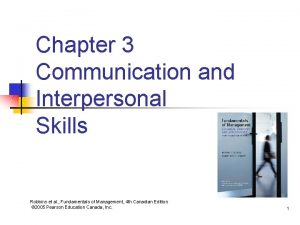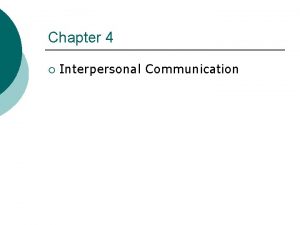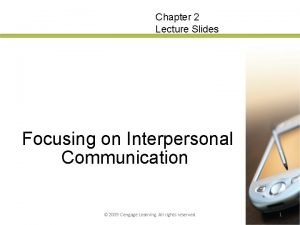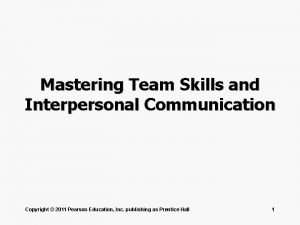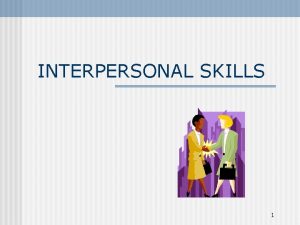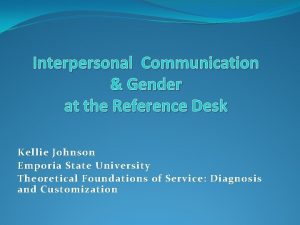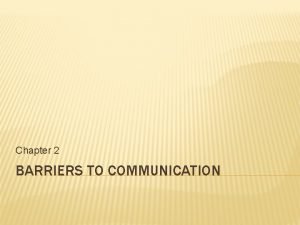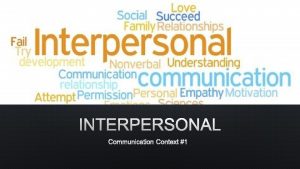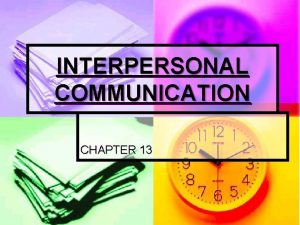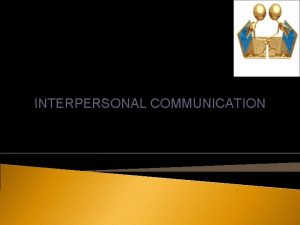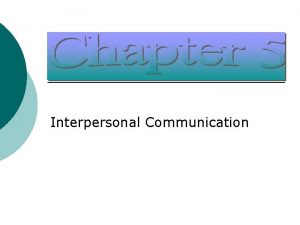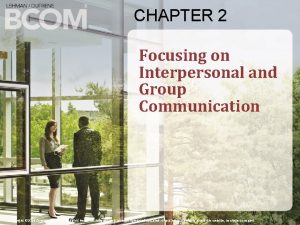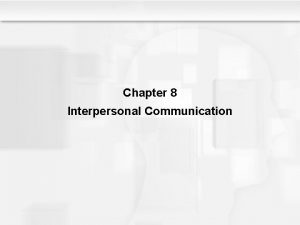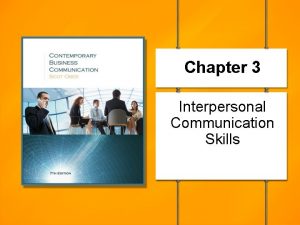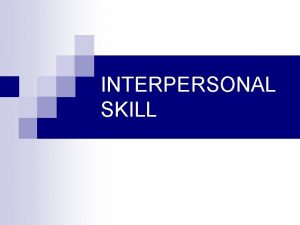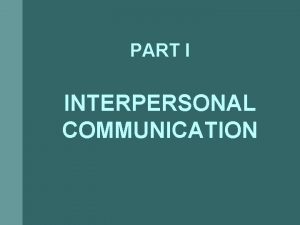Chapter 2 Focusing on Interpersonal and Group Communication
















- Slides: 16

Chapter 2 Focusing on Interpersonal and Group Communication Business Communication, 14 e Lehman and Du. Frene Business Communication, 14 th edition by Lehman and Du. Frene Copyright 2005 by South-Western, a division of Thomson Learning

Chapter 2 Behavioral Theories Impact Communication © Maslow’s Hierarchy of Needs © Stroking © Johari Window © Mc. Gregor’s Theory X and Y © Hersey and Blanchard’s Situational Leadership Model Business Communication, 14 th edition by Lehman and Du. Frene Copyright 2005 by South-Western, a division of Thomson Learning

Chapter 2 Mc. Gregor’s Management Styles Theory Y Theory X © Workers inherently dislike work © Workers like challenging work © Talent is narrowly distributed among only a few © Talent is widely distributed throughout the workforce © Workers will do as little work as they are required to do © Workers can be motivated to work independently Business Communication, 14 th edition by Lehman and Du. Frene Copyright 2005 by South-Western, a division of Thomson Learning

Chapter 2 Hersey & Blanchard’s Situational Leadership Model Directive behavior Supportive behavior Detailed rules and instructions and close monitoring Listening, communicating, recognizing, and encouraging Leadership style must be appropriate for the follower and the task to be performed. Business Communication, 14 th edition by Lehman and Du. Frene Copyright 2005 by South-Western, a division of Thomson Learning

Chapter 2 Trust Leads to Reciprocal Sharing Depicted in Expanded Open Area in Johari Window Business Communication, 14 th edition by Lehman and Du. Frene Copyright 2005 by South-Western, a division of Thomson Learning

Chapter 2 Nonverbal Communication Conveys Added Meaning © © © Metacommunication — Not expressed in words but accompanies a verbal message Visual — All types of body movements (gestures, eye contact, and facial expressions) — Attire and grooming Vocal — Tone and projection Business Communication, 14 th edition by Lehman and Du. Frene Copyright 2005 by South-Western, a division of Thomson Learning

Chapter 2 Understanding Nonverbal Messages © Extend the meaning of the message and sender’s background and motives © Vary between people and cultures © May be intentional or unintentional © May contradict and receive more attention than the verbal message © Can be beneficial or harmful Business Communication, 14 th edition by Lehman and Du. Frene Copyright 2005 by South-Western, a division of Thomson Learning

Chapter 2 Bad Listening Habits © Faking attention © Allowing disruptions © Overlistening © Stereotyping © Dismissing subjects as uninteresting © Failure to observe nonverbal aids Business Communication, 14 th edition by Lehman and Du. Frene Copyright 2005 by South-Western, a division of Thomson Learning

Chapter 2 Effective Listeners. . . © © © © Minimize distractions Get in touch with the speaker Use knowledge of the speaker to advantage Indicate their active involvement Do not interrupt unnecessarily Ask reflective questions Send probing prompts to the speaker Use lag time wisely Business Communication, 14 th edition by Lehman and Du. Frene Copyright 2005 by South-Western, a division of Thomson Learning

Chapter 2 Characteristics of Effective Teams © © © © Common goals Role perception Longevity Size Status Group norms Leadership Business Communication, 14 th edition by Lehman and Du. Frene Copyright 2005 by South-Western, a division of Thomson Learning

Chapter 2 Team Roles Positive Negative Isolate © Dominator © Free rider © Detractor © Digressor © Airhead © Socializer © Business Communication, 14 th edition by Lehman and Du. Frene Facilitator © Harmonizer © Record keeper © Reporter © Leader © Copyright 2005 by South-Western, a division of Thomson Learning

Chapter 2 Stages of Team Development Performing Productivity Reaching the optimal performance level Norming Developing strategies and activities that promote goal achievement Storming Dealing with conflict, personalities, goals, and ideas Forming Getting acquainted with each other and the task Business Communication, 14 th edition by Lehman and Du. Frene Copyright 2005 by South-Western, a division of Thomson Learning

Chapter 2 Team Behaviors © Commitment © Cooperation © Communication © Contribution Business Communication, 14 th edition by Lehman and Du. Frene Copyright 2005 by South-Western, a division of Thomson Learning

Chapter 2 Face-to-Face Meetings Limitations Advantages Provide rich, nonverbal cues © Are preferred when dealing with sensitive issues © Are beneficial for establishing group rapport and relationships © Business Communication, 14 th edition by Lehman and Du. Frene © Pose logistical issues of time, place, and schedules © May be dominated by overly vocal, quick-tospeak, and high status members Copyright 2005 by South-Western, a division of Thomson Learning

Chapter 2 Electronic Meetings Limitations Advantages © Facilitate geographically dispersed groups © Cannot replace faceto-face contact for certain type meetings © Speed up meeting follow-up activities © Can make consensus harder to reach © Place all participants on a more even level © Are dependent on participants having excellent keyboarding skills Business Communication, 14 th edition by Lehman and Du. Frene Copyright 2005 by South-Western, a division of Thomson Learning

Chapter 2 Suggestions for Effective Meetings Limit meeting length and frequency © Make satisfactory arrangements © Distribute the agenda well in advance © Encourage participation © Maintain order © Manage conflict and seek consensus © Prepare thorough minutes © Business Communication, 14 th edition by Lehman and Du. Frene Copyright 2005 by South-Western, a division of Thomson Learning
 Types of nonverbal communication chronemics
Types of nonverbal communication chronemics Lwws
Lwws Chapter 6 interpersonal communication
Chapter 6 interpersonal communication Chapter 5 interpersonal communication
Chapter 5 interpersonal communication Chapter 3 interpersonal communication
Chapter 3 interpersonal communication Noise in communication
Noise in communication Chapter 12 interpersonal communication
Chapter 12 interpersonal communication Interpersonal communication chapter 6
Interpersonal communication chapter 6 Chapter 8 interpersonal communication
Chapter 8 interpersonal communication Interpersonal communication chapter 2
Interpersonal communication chapter 2 Intra and interpersonal skills
Intra and interpersonal skills Mastering team skills and interpersonal communication
Mastering team skills and interpersonal communication What are interpersonal skills
What are interpersonal skills Gender interpersonal communication
Gender interpersonal communication Interpersonal communication and emotional intelligence
Interpersonal communication and emotional intelligence Communication skills in cv
Communication skills in cv Communication selectivity barriers examples
Communication selectivity barriers examples




